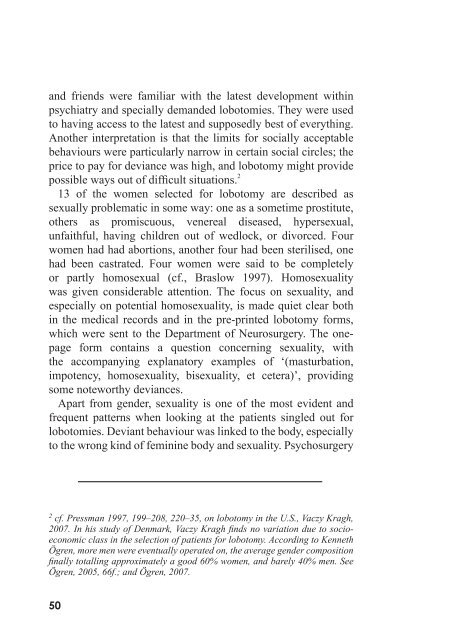Thinking with Bevereley Skeggs - Stockholms universitet
Thinking with Bevereley Skeggs - Stockholms universitet
Thinking with Bevereley Skeggs - Stockholms universitet
- No tags were found...
Create successful ePaper yourself
Turn your PDF publications into a flip-book with our unique Google optimized e-Paper software.
and friends were familiar <strong>with</strong> the latest development <strong>with</strong>inpsychiatry and specially demanded lobotomies. They were usedto having access to the latest and supposedly best of everything.Another interpretation is that the limits for socially acceptablebehaviours were particularly narrow in certain social circles; theprice to pay for deviance was high, and lobotomy might providepossible ways out of difficult situations. 213 of the women selected for lobotomy are described assexually problematic in some way: one as a sometime prostitute,others as promiscuous, venereal diseased, hypersexual,unfaithful, having children out of wedlock, or divorced. Fourwomen had had abortions, another four had been sterilised, onehad been castrated. Four women were said to be completelyor partly homosexual (cf., Braslow 1997). Homosexualitywas given considerable attention. The focus on sexuality, andespecially on potential homosexuality, is made quiet clear bothin the medical records and in the pre-printed lobotomy forms,which were sent to the Department of Neurosurgery. The onepageform contains a question concerning sexuality, <strong>with</strong>the accompanying explanatory examples of ‘(masturbation,impotency, homosexuality, bisexuality, et cetera)’, providingsome noteworthy deviances.Apart from gender, sexuality is one of the most evident andfrequent patterns when looking at the patients singled out forlobotomies. Deviant behaviour was linked to the body, especiallyto the wrong kind of feminine body and sexuality. Psychosurgery2cf. Pressman 1997, 199–208, 220–35, on lobotomy in the U.S., Vaczy Kragh,2007. In his study of Denmark, Vaczy Kragh finds no variation due to socioeconomicclass in the selection of patients for lobotomy. According to KennethÖgren, more men were eventually operated on, the average gender compositionfinally totalling approximately a good 60% women, and barely 40% men. SeeÖgren, 2005, 66f.; and Ögren, 2007.50
















